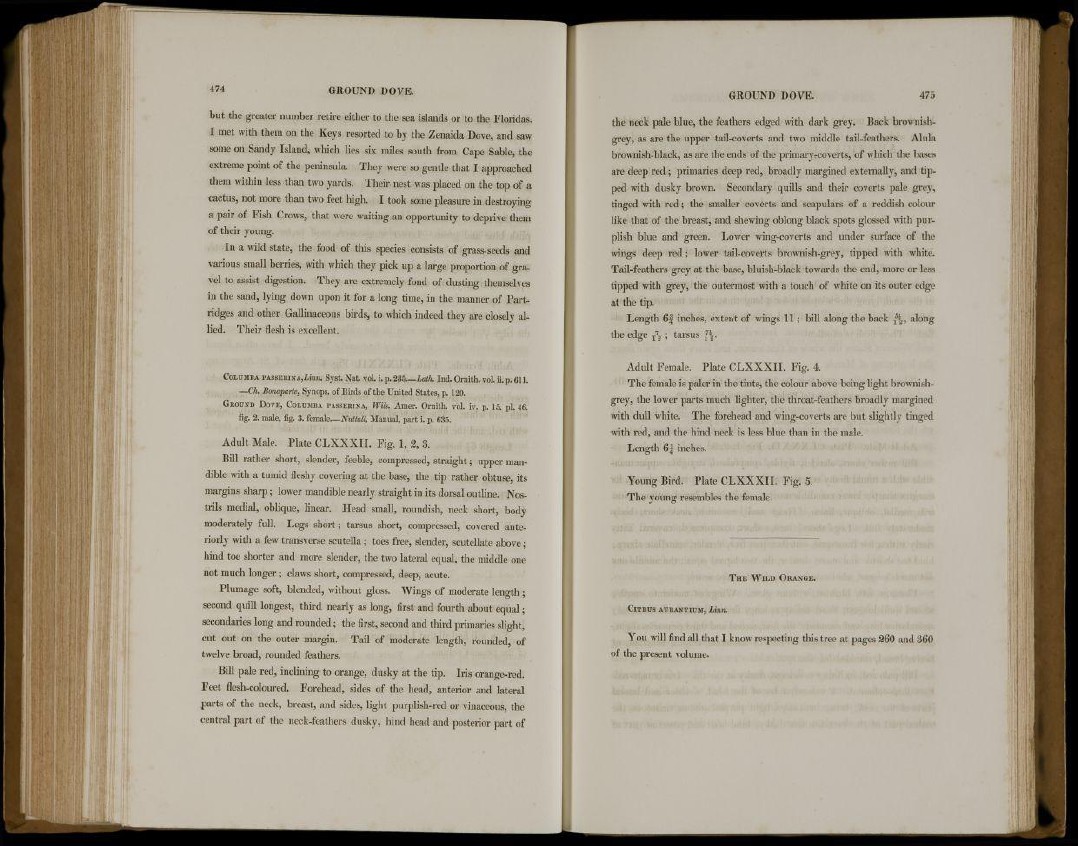
but the greater number retire either to the sea islands or to the Floridas.
I met with them on the Keys resorted to by the Zenaida Dove, and saw
some on Sandy Island, which lies six miles south from Cape Sable, the
extreme point of the peninsula. They were so gentle that I approached
them within less than two yards. Their nest was placed on the top of a
cactus, not more than two feet high. I took some pleasure in destroying
a pair of Fish Crows, that were waiting an opportunity to deprive them
of their young.
In a wild state, the food of this species consists of grass-seeds and
various small berries, with which they pick up a large proportion of gravel
to assist digestion. They are extremely fond of dusting themselves
in the sand, lying down upon it for a long time, in the manner of Partridges
and other Gallinaceous birds, to which indeed they are closely allied.
Their flesh is excellent.
COLUMBA PASSEttiNA,Z.t7m. Syst. Nat. vol. i. p. 285.—Lath. Ind. Ornith. vol. ii. p. 611.
—Ch. Bonaparte, Synops. of Birds of the United States, p. 120.
GROUND DOVE, COLUMBA I'ASSERINA, Wils. Amer. Ornith. vol. iv. p. 15. pi. 46.
fig. 2. male, fig. 3 . female.—Nuttall, Manual, part i. p. 635.
Adult Male. Plate CLXXXII. Fig. 1, 2, 3.
Bill rather short, slender, feeble, compressed, straight; upper mandible
with a tumid fleshy covering at the base, the tip rather obtuse, its
margins sharp; lower mandible nearly straight in its dorsal outline. Nostrils
medial, oblique, linear. Head small, roundish, neck short, body
moderately full. Legs short; tarsus short, compressed, covered anteriorly
with a few transverse scutella ; toes free, slender, scutellate above;
hind toe shorter and more slender, the two lateral equal, the middle one
not much longer; claws short, compressed, deep, acute.
Plumage soft, blended, without gloss. Wings of moderate length ;
second quill longest, third nearly as long, first and fourth about equal;
secondaries long and rounded; the first, second and third primaries slight,
cut out on the outer margin. Tail of moderate length, rounded, of
twelve broad, rounded feathers.
Bill pale red, inclining to orange, dusky at the tip. Iris orange-red.
Feet flesh-coloured. Forehead, sides of the head, anterior and lateral
parts of the neck, breast, and sides, light purplish-red or vinaceous, the
central part of the neck-feathers dusky, hind head and posterior part of
the neck pale blue, the feathers edged with dark grey. Back brownishgrey,
as are the upper tail-coverts and two middle tail-feathers. Alula
brownish-black, as are the ends of the primaryrcoverts, of which the bases
are deep red; primaries deep red, broadly margined externally, and tipped
with dusky brown. Secondary quills and their coverts pale grey,
tinged with red; the smaller coverts and scapulars of a reddish colour
like that of the breast, and shewing oblong black spots glossed with purplish
blue and green. Lower wing-coverts and under surface of the
wings deep red ; lower tail-coverts brownish-grey, tipped with white.
Tail-feathers grey at the base, bluish-black towards the end, more or less
tipped with grey, the outermost with a touch of white on its outer edge
at the tip.
Length 6 | inches, extent of wings 1 1 ; bill along the back T
5 J
g , along
the edge T
7
2 ; tarsus l\.
Adult Female. Plate CLXXXII. Fig. 4.
The female is paler in the tints, the colour above being light brownishgrey,
the lower parts much lighter, the throat-feathers broadly margined
with dull white. The forehead and wing-coverts are but slightly tinged
with red, and the hind neck is less blue than in the male.
Length 6£ inches.
Young Bird. Plate CLXXXII. Fig. 5.
The young resembles the female.
THE WILD ORANGE.
CITRUS AURANTIUM, Linn.
You will find all that I know respecting this tree at pages 260 and 36*0
of the present volume.